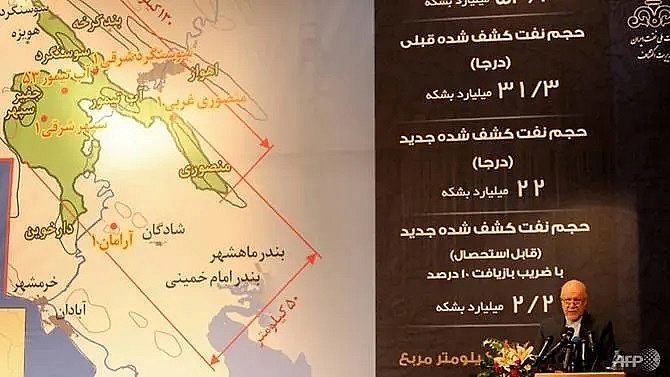Iran says new oil find adds only 22 billion barrels to reserves
 |
| Iran's Oil Minister Bijan Namdar Zanganeh said some 2.2 billion barrels could be extracted from the newly-discovered reserve. (Photo: AFP/Atta Kenare) |
Out of the amount at the site, only a tenth - 2.2 billion barrels - can be extracted due to technological limitations, the minister, Bijan Namdar Zanganeh, told reporters in Tehran.
Rouhani on Sunday announced the discovery of a field containing 53 billion barrels of oil in the southwestern province of Khuzestan, saying it was a "small gift by the government to the people of Iran".
The oil minister said the discovery added 22.2 billion barrels to the country's oil reserves.
"Considering that there was already 31 billion barrels of oil (in the region), the in situ amount added is 22.2 billion barrels," he said.
Due to the area's "dense and stone material", the amount that can be extracted is only "2.2 billion barrels, considering the current technology we have," he added.
The discovery spans 2,400 square kilometres, according to a map Zanganeh showed journalists.
It could potentially be expanded towards to southwest and east through further exploration.
The oil layer is about 3.1 kilometres deep, with an average thickness of 80 metres (yards).
Iran is a founding member of the Organization of the Petroleum Exporting Countries (OPEC).
It sits on the world's fourth-biggest oil reserves, estimated by energy giant BP at 155.6 billion barrels of crude, and also has the second-largest gas reserves.
Yet the Islamic republic has struggled to sell its oil since US President Donald Trump withdrew from a landmark 2015 nuclear deal and reimposed unilateral sanctions on Iran.
The remaining parties to the accord - Britain, China, France, Germany and Russia - have worked to save it by finding ways to bypass US sanctions, but their efforts have so far borne little fruit.
What the stars mean:
★ Poor ★ ★ Promising ★★★ Good ★★★★ Very good ★★★★★ Exceptional
 Tag:
Tag:
Related Contents
Latest News
More News
- 72 nations sign landmark Hanoi cybercrime convention (October 26, 2025 | 18:00)
- UN Secretary-General commends Vietnam’s global leadership (October 26, 2025 | 09:00)
- APEC finance ministers convene to tackle regional challenges (October 22, 2025 | 17:31)
- Rewiring global trade: ASEAN’s rise as supply chain hub (October 17, 2025 | 11:40)
- Vietnam attends first World Nuclear Week Forum in Russia (September 26, 2025 | 10:50)
- Vietnam attends 69th session of IAEA General Conference (September 16, 2025 | 10:00)
- ADB, WB pledge over 12 billion USD for ASEAN power grid, renewable energy projects (August 15, 2025 | 14:18)
- Lowy Institute proposes AI-based tobacco control solutions for ASEAN (August 15, 2025 | 14:14)
- Cloud computing policy to position Malaysia as regional hub by 2030 (August 15, 2025 | 14:11)
- Thailand, Cambodia suffer numerous cyber attacks (August 05, 2025 | 16:19)
























 Mobile Version
Mobile Version